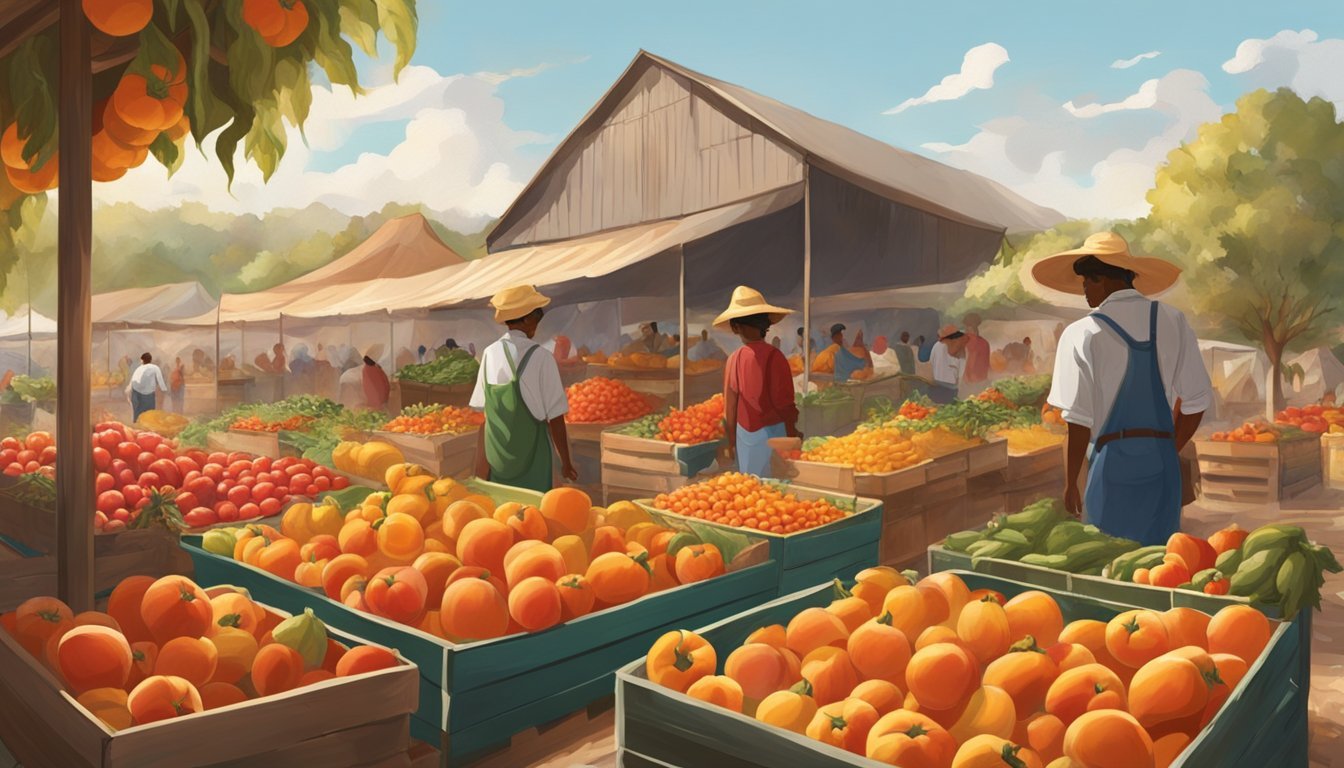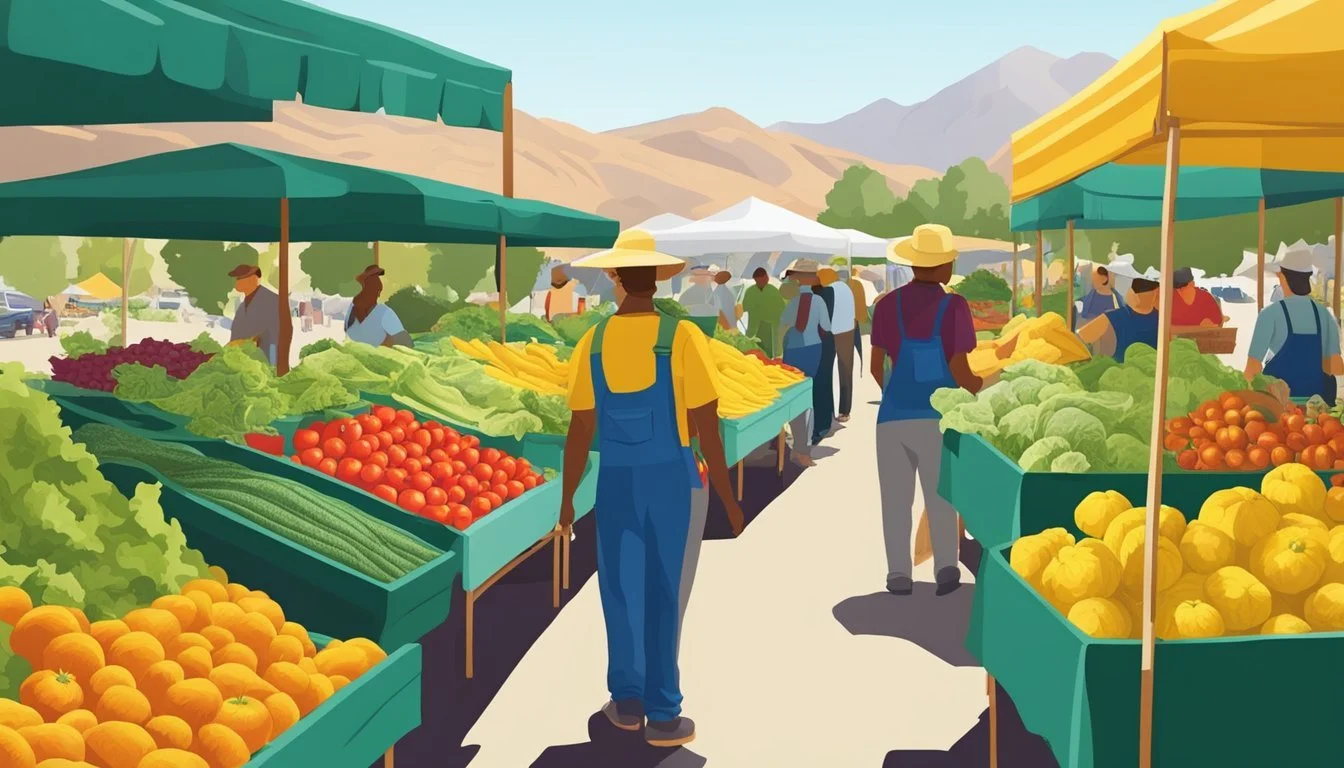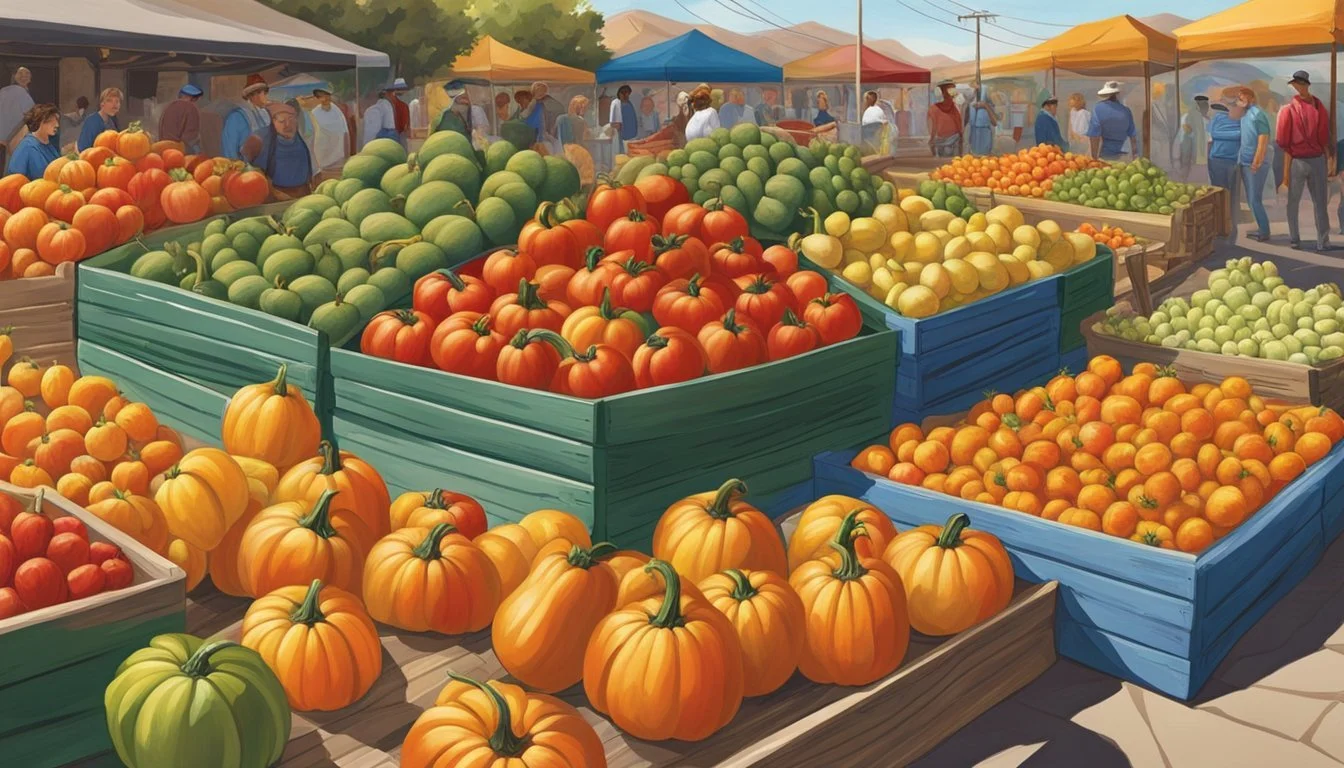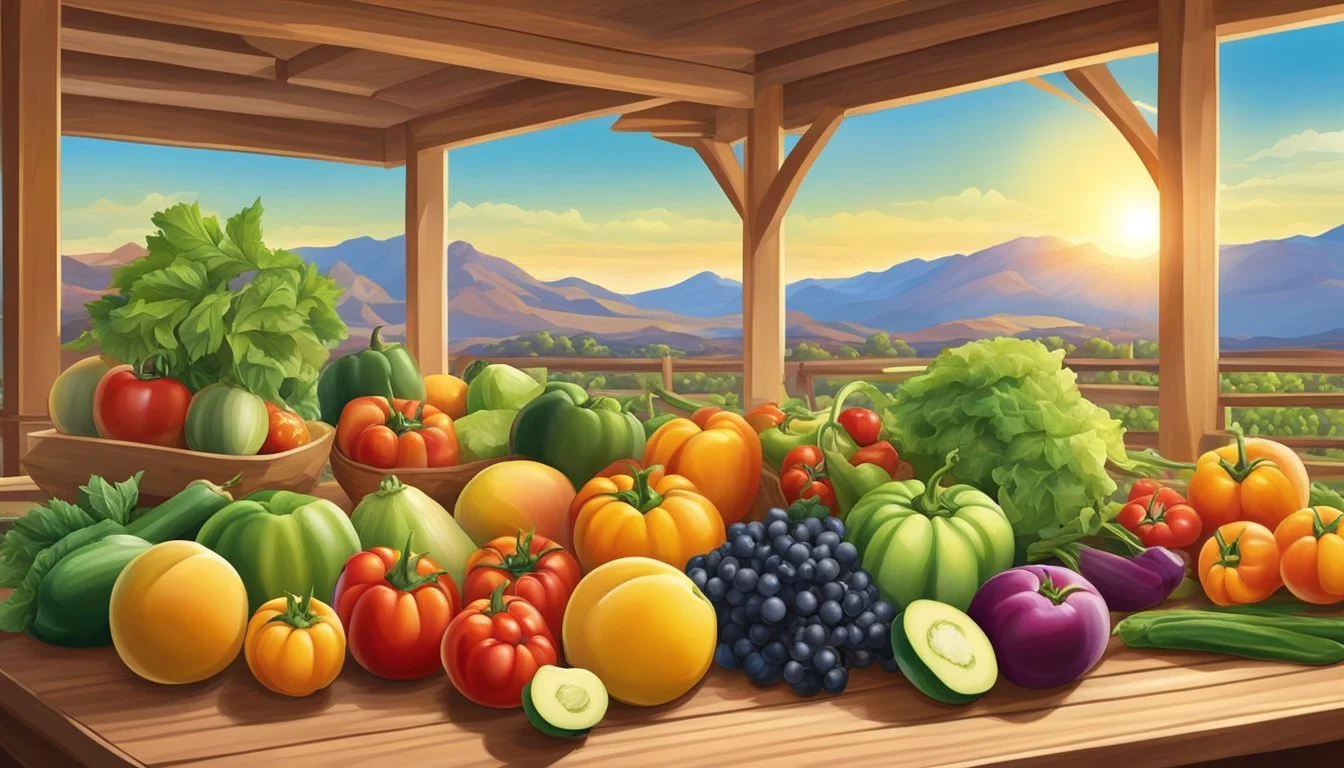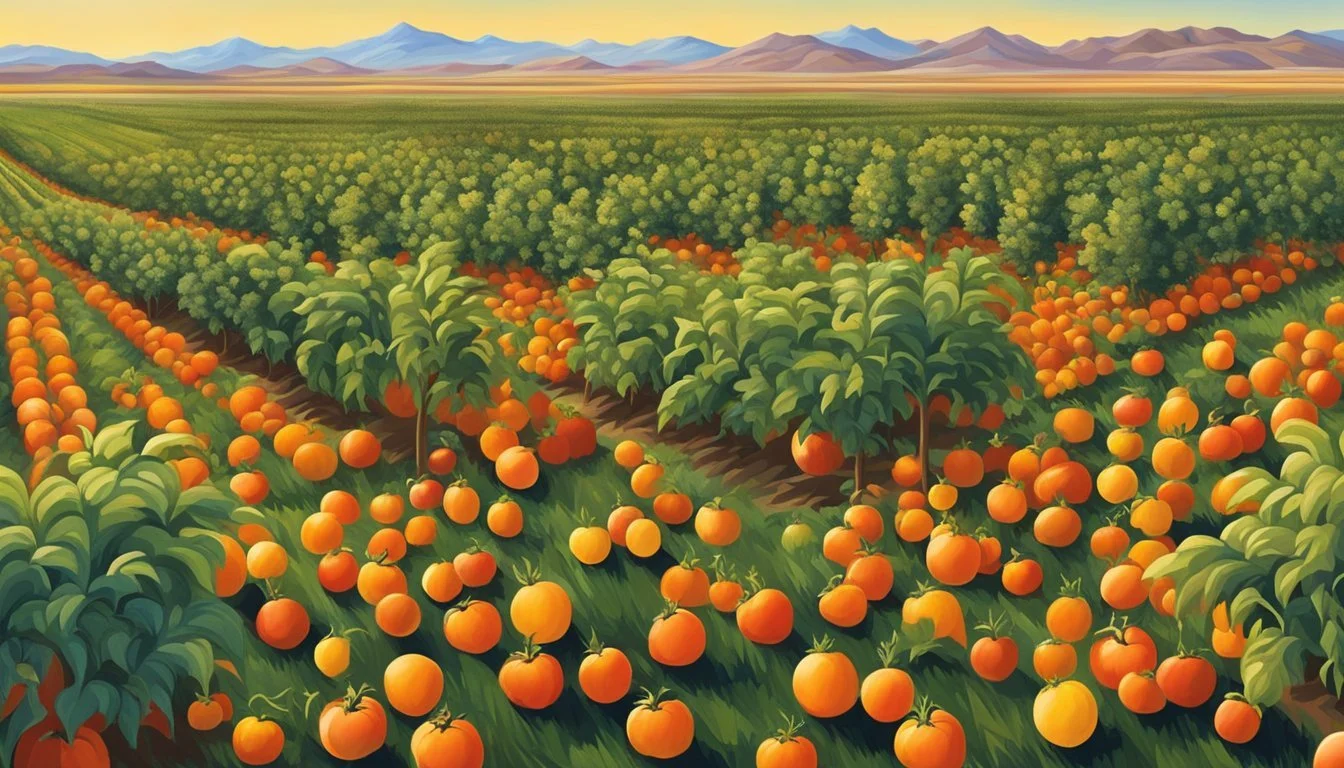Nevada Seasonal Fruit & Vegetables in September
A Fresh Guide to Autumn Harvests
This Article is Part of our Nevada Seasonal Fruit & Veg Calendar
Nevada's diverse climate creates a conducive environment for growing a variety of fruits and vegetables, particularly in the month of September. This is a period when the summer heat begins to soften, allowing for a unique harvest season that brings freshness and flavor to the local cuisine. The state's agricultural collection during this month is characterized by an abundance of produce, with options ranging from leafy greens to succulent fruits.
During September, local farmers' markets and grocery stores are stocked with seasonal produce harvested at its peak. It is the prime time for residents and chefs to savor the nutritional value and taste of freshly picked goods. Beets, broccoli (how long does broccoli last?), and cabbage, among other vegetables, flourish and are readily available throughout the state.
In the realm of fruits, September in Nevada sees a range of berries and melons, offering a sweet and refreshing taste to balance the still-warm days. The tail end of summer yields the last of the blackberries (how long do blackberries last?) and brings forth ripe cantaloupes (how long does cantaloupe last?). This seasonal shift not only supports a sustainable food system but also encourages a culinary exploration of the region's freshest ingredients.
Fruit Harvest in September
September in Nevada brings a bountiful harvest of various fruits, with apples (how long do apples last?) and pears reaching ripeness and berries offering their last flush of the season. Melons and stone fruits also make their notable appearance during this transition into autumn.
Apples and Pears
Nevada’s cooler areas usher in the harvest of crisp apples and juicy pears this month. One might find varieties such as 'Gala' apples and 'Bartlett' pears, both praised for their sweet flavors and versatility.
Apples: 'Gala', 'Honeycrisp', 'Granny Smith'
Pears: 'Bartlett', 'Bosc', 'D'Anjou'
Berries and Melons
September sees the tail end of the berry season, with blackberries and raspberries available for picking. Meanwhile, various melons, including watermelons, are at their peak, offering a refreshing taste amidst the warmer days.
Blackberries: Sweet and plump, ideal for jams and desserts
Raspberries: Delicate and tart, suitable for fresh eating and recipes
Melons: Including cantaloupes and honeydews
Watermelon: Juicy and hydrating, perfect for outdoor gatherings
Stone Fruits
The stone fruit season concludes with flavorful peaches and plums. These fruits are cherished for their sweet and tangy profiles and are often enjoyed fresh or used in various culinary creations.
Peaches: Clingstone and freestone varieties
Plums: Including 'Santa Rosa' and 'Italian Prune'
Each specified fruit during September is ripe for the picking and savored by Nevadans, ensuring a diverse and delicious end to the summer season.
Vegetable Picks for September
September in Nevada showcases a rich bounty of vegetables, making it a perfect time for locals to indulge in fresh, nutrient-rich produce. With a change in season, heavier root vegetables come to the forefront, while the final batches of summer crops are still available for harvest.
Root Vegetables and Squash
Nevada’s September soil yields an impressive variety of root vegetables and squash.
Sweet Potatoes: These tubers are not only versatile but packed with vitamins and fiber.
Pumpkins: As fall approaches, pumpkins start coming into season, hinting at the upcoming festivities.
Radishes: Offering a peppery crunch, radishes make a fresh addition to any dish.
Zucchini: Though nearing the end of their season, zucchini is still plentiful.
Summer Squash: Like zucchini, summer squash is in its final days of peak freshness.
Winter Squash: With a slightly sweeter taste, winter squash begins to take over as the season progresses.
Leafy Greens
The cooler temperatures of September provide an ideal climate for leafy greens in Nevada.
Kale: Hardy and nutritious, kale thrives in the cooling weather.
Lettuce: There's an array of lettuce varieties to choose from that remain crisp during this month.
Spinach: This leafy green is known for its versatility and nutrient density.
Nightshades and Others
September also offers the last harvest of nightshades and other vegetables.
Peppers: A range of peppers from sweet to spicy continue to ripen beautifully in the early fall sun.
Eggplant (how long does eggplant last?): With their deep purple hue, eggplants add a subtle, earthy flavor to any meal.
Tomatoes: As a quintessential summer crop, tomatoes are still available but will soon make their exit for the year.
Corn: Corn’s sweet, juicy kernels are at their prime, soon to conclude their season.
Seasonal Selections Transition
As September arrives in Nevada, it marks a significant shift in the agricultural landscape. The state begins to bid farewell to the bountiful summer harvest and transitions to the more subdued offerings of fall, preparing the ground for the onset of early winter.
Summer to Fall Transition
In September, Nevada's farms experience a changeover from the sweet and vibrant flavors of summer to the warming and earthy tones of fall. While berries that adorned the summer tables start to wane, a variety of squash begin to take prominence, offering a new palette of flavors and textures.
Berries: Blackberries linger into early September but soon finish their season.
Squash: Varieties such as acorn, butternut, and spaghetti squash become abundant, reflecting the heartier autumnal produce.
Greens like kale and spinach thrive in cooler temperatures, becoming staples as the months progress. They retain their sweet undertones, which are often enhanced after the first frost.
Preparing for Early Winter
Nevada's harvest in September is not just about what is in season but also what needs to be prepared for the coming colder months. Farmers and gardeners start to plant and nurture crops that will survive and even benefit from the cool to harsh temperatures of early winter.
Winter Squash: Crops meant to be harvested in winter are planted and cared for, including various kinds of winter squash that store well and can be used throughout the season.
Greens: Hardier greens are sowed in September to ensure a continuous supply. These greens often sweeten with the cold, giving salads and cooked dishes a pleasant flavor profile.
By understanding these transitions, consumers and chefs can make informed decisions on fresh, seasonal produce that supports local agriculture and provides the most flavorful experience.
Culinary Ideas for Seasonal Produce
In September, Nevada's bountiful harvest offers a variety of fruits and vegetables ideal for fresh, roasted, or preserved culinary creations. Each preparation method brings out the unique flavors and textures of these seasonal offerings.
Salads and Raw Preparations
The freshness of September produce in Nevada lends itself beautifully to salads and raw dishes. For a crisp and refreshing option, one might combine thinly sliced carrots (how long do carrots last?) and celery (how long does celery last?) with a tangy vinaigrette. Blackberries add a sweet and tart note to a colorful salad, providing a delightful contrast to the savory flavors of fresh greens.
Salad Base: Mixed greens, arugula (how long does arugula last?), or spinach
Add-ons: Sliced carrots, diced celery, blackberries
Dressing: Citrus vinaigrette or balsamic reduction
Warm Dishes and Sides
The cooler evenings of early fall invite the comfort of warm dishes featuring seasonal vegetables. Roasting enhances the natural sweetness of produce such as broccoli, cauliflower (how long does cauliflower last?), and carrots. Soups with a base of roasted vegetables (What wine goes well with roasted vegetables?) not only provide warmth but also allow for a melding of flavors that highlight the harvest's diversity.
Roasted Vegetables: Broccoli and cauliflower florets, carrot rounds, tossed in olive oil, seasoned with salt, pepper, and thyme
Soup Combination: Pureed roasted vegetables with stock for a creamy soup
Preserves and Desserts
September's fruits are perfect for preserves and desserts, capturing the essence of late summer sweetness. Creating jams from blackberries or incorporating them into tarts allows these fruits to be savored far beyond their seasonal window. Preserving fruits in sugar or transforming them into desserts not only extends their life but also offers a taste of Nevada's fall throughout the year.
Jam: Blackberry jam with lemon zest (how long does lemon zest last?)
Dessert: Blackberry tart with a buttery crust, garnished with fresh mint leaves
Health Benefits of Seasonal Consumption
Consuming seasonal fruits and vegetables in Nevada during September offers a variety of health benefits. Fresh produce harvested at peak ripeness is often more nutritious and flavorful. For example, September's seasonal fruits such as blackberries and apricots are typically higher in essential vitamins and antioxidants when consumed within their natural harvest season.
Freshness: Seasonal produce is often harvested at its peak and sold soon after, retaining more nutrients.
Nutritious Varieties: A wider range of fruits and vegetables promotes a diverse intake of nutrients.
Eating a diet rich in fruits and vegetables correlates with a reduced risk of many lifestyle-related health conditions. September harvests like arugula and beets provide essential dietary fiber, vitamins, and minerals essential for maintaining good health.
In Nevada, the local produce in September may include, but is not limited to:
Fruit Vegetable Apricots Arugula Blackberries Beets
These fruits and vegetables contain vitamins such as vitamin C and K, folate, and health-promoting phytochemicals, which can boost immunity and reduce inflammation. By choosing seasonal, shoppers are more likely to get produce that hasn't lost nutrient value due to long transport times.
Incorporating seasonal fruits and vegetables into one's diet supports not only personal health but also the local economy. It encourages sustainable agriculture by reducing the carbon footprint associated with transporting non-local produce. This conscious choice benefits both consumers' health and the environment.
Nevada's Farming and Agriculture
In September, Nevada's agricultural scene thrives with local farms emphasizing sustainable practices and communities gathering at agricultural events and farmers markets.
Local Farms and Sustainability
Nevada's local farms are dedicated to sustainable agriculture, ensuring that the state's arid climate does not hamper their output. Farmers in the region adapt by choosing crops that are suitable for the climate, such as apricots and arugula, which can thrive with less water usage. Water conservation techniques and innovative irrigation methods are central to the state's farming success, supporting a sustainable food system.
Water-Efficient Crops: Including Opuntia ficus-indica (prickly pear), which uses significantly less water.
Conservation Practices: Adoption of drip irrigation and other water-saving technologies.
Agricultural Events and Farmers Markets
September in Nevada is a vibrant time for agricultural events and farmers markets. These venues serve as a nexus for local producers to offer fresh, seasonal produce directly to the community. They foster a connection between consumers and the origins of their food, highlighting the importance of supporting local agriculture.
Farmers Market Locations:
City Market Name Schedule Las Vegas Downtown Farmers Market Thursdays Reno Riverside Farmers Market Saturdays
Seasonal Produce Available:
Fruits: Blackberries, Blueberries
Vegetables: Arugula, Beets, Broccoli
Attendees of farmers markets in September can enjoy the late summer harvest, including the last of the berries and a variety of greens and root vegetables. These events showcase the state's farming prowess and commitment to local, sustainable produce.
Recipe Ideas and Cooking Tips
In September, Nevada's bounty includes a variety of fruits and vegetables perfect for a blend of simple, healthy dishes and more indulgent, flavorful treats. This section offers cooking tips and recipe ideas to make the most of the season's produce.
Simple and Healthy Recipes
Utilizing September's fresh produce, cooks can create dishes that are both nutritious and delicious. For instance, salads featuring cantaloupe, figs, and apples alongside leafy greens offer a refreshing meal. Adding a sprinkle of nuts or seeds tops it off with a crunchy texture.
Figs: Figs can be added to salads with spinach, rocket, and thinly sliced apples. Top with a balsamic vinaigrette for a blend of sweet and tangy flavors.
Apples: Slice apples and toss them in a mixture of lemon juice and cinnamon for a quick, healthy snack. They can also be diced into oatmeal for breakfast.
Incorporating vegetables like broccoli and cauliflower into one's diet is easily done through stir-fries or steamed sides. Light seasoning with herbs enhances the natural flavors without overpowering.
Broccoli: Steam broccoli and finish with a sprinkle of lemon zest and red pepper flakes (how long do red pepper flakes last?) for an easy side dish.
Cauliflower: Roast cauliflower florets with a pinch of cumin and garlic for a hearty addition to any main course.
Indulgent Treats and Baking
September's fruits lend themselves to an array of baked goods and sweet treats. Baking brings out the natural sweetness and depth of flavors, making for irresistible desserts.
Peaches and Pears: These can be sliced and layered into pies or tarts. The caramelization of the fruits' sugars during the baking process enriches their taste.
Blackberries and Blueberries: Perfect for folding into muffin batter or simmering into jams and berry compotes.
Recipes like blackberry cobblers or blueberry crumbles not only satisfy sweet tooth cravings but also fill the kitchen with inviting aromas.
Grapes: Try roasting grapes to concentrate their sweetness and serve over ice cream or as a cheese plate accompaniment.
Bakers should take advantage of the cooler evenings to warm their homes with the scents of baked goods featuring September's selection of fruits. It's a delightful way to celebrate the transition into the fall season.
Storing and Preserving Tips
When handling Nevada's seasonal fruits and vegetables in September, maintaining freshness is paramount. Storing correctly extends shelf life and ensures quality. For robust items like carrots and cabbage, one should store them in a cool, humid environment, often a refrigerator's crisper drawer suffices.
For tomatoes, they should be kept at room temperature away from direct sunlight to prevent over-ripening. Once ripe, they may be refrigerated to slow down decay. Beets can be stored in the refrigerator, but their greens should be removed to prevent moisture loss.
Cantaloupes and summer squashes, once cut, need refrigeration in an air-tight container. However, until slicing, they should be kept at a cool room temperature. Basil must avoid cold temperatures, which can turn its leaves black. It's best left in a glass of water, as one would fresh-cut flowers, and placed on a countertop.
Preserving methods such as freezing, pickling, and canning are effective for longevity. Broccoli and cauliflower should be blanched before freezing to preserve their texture and flavor. Fruits like blackberries can be frozen on a tray before transferring to a freezer bag to prevent clumping.
Quick Reference Chart
Vegetable/Fruit Storage Method Preservation Method Carrots Refrigerate in plastic bags Can, freeze Cabbage Cool, humid environment Pickle Tomatoes Room temperature, then refrigerate if needed Can, freeze Basil Glass of water, room temperature Dry, freeze in oil Blackberries Refrigerate; do not wash until use Freeze, make jams Cantaloupes Room temperature to ripen, then refrigerate Freeze, can
By adhering to the appropriate storing and preserving techniques, one maximizes the shelf life and flavor of September's seasonal bounty in Nevada.

